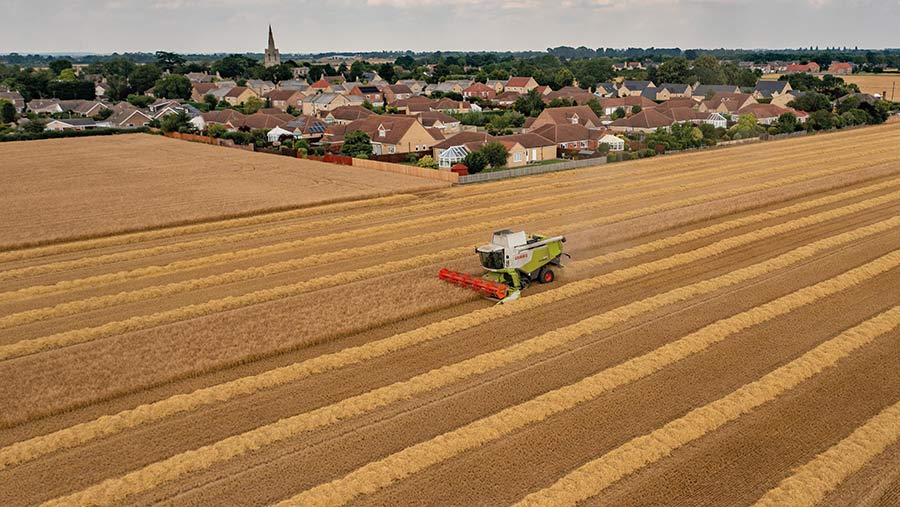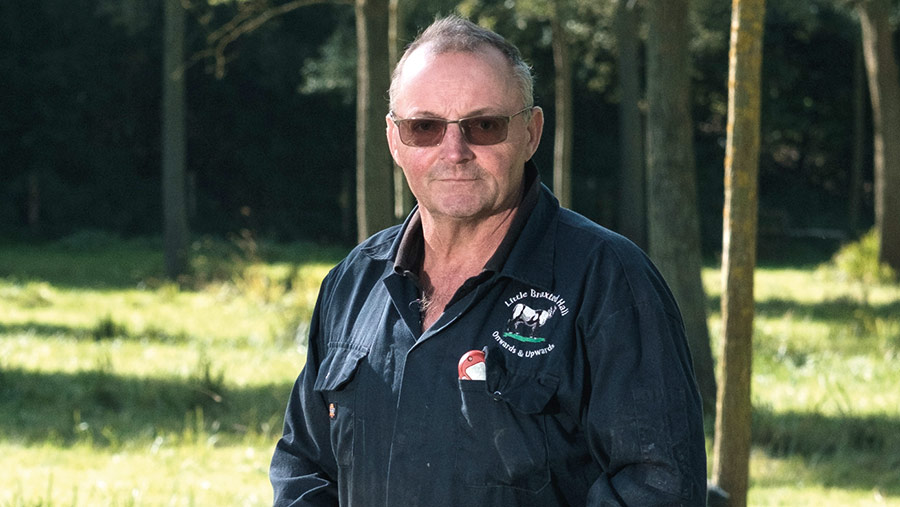How to stress-test your farm business against high inflation
 © Tim Scrivener
© Tim Scrivener Soaring input costs are putting a severe strain on farm cashflows – but growers and livestock producers can take steps to lessen the impact of rising ag inflation.
With little relief expected in the foreseeable future, farmers are being encouraged to improve their budgeting and cost management skills, and avoid taking unnecessary risks.
Input costs have climbed to their highest level for decades since Russia invaded Ukraine in February, adding to the uncertainty of an already volatile marketplace and commodity supply chains struggling to recover from the coronavirus pandemic.
See also: Plan cash flow now for bigger January tax bills
Ag inflation now stands at 25.3%, according the latest figures from farm business consultant Andersons.
This is almost three times the Consumer Prices Index, which is itself set to remain at elevated levels for at least the remainder of the year.
Largely due to feed, fuel and fertiliser price increases, these inflationary pressures are coming at a time when all farms in England face further cuts in their basic payment, which will reduce by 35% during 2023.
While some sectors are withstanding the pressure better than others, attention is turning to the outlook for next year.
The combination of high input costs and tax on 2022 profits will stretch working capital requirements and demand tight financial management.
Even profitable businesses may need to have higher overdraft facilities for 2023 to finance higher input costs and meet their tax obligations.
The four Fs: Feed, fuel, fertiliser and finance
Feed, fuel and fertiliser costs have all risen substantially. Now finance could become a big cost for farm businesses too, suggests Nick Evans, managing director of Oxbury, the specialist agricultural bank.
“Funding, or finance, could become a big number and will need to be monitored,” he says.
“Farmers have gone out and bought nitrogen fertiliser at £650-£700/t on the basis that they will receive more for their crops or output – often helped by forward sales – but there is still plenty of uncertainty around markets.”
With so many inflationary factors at play – including geographical, political and climatic influences – even the experts admit it is difficult to know where things are heading.
But action can be taken to reduce exposure to uncertainty.
“Forward selling a proportion of your crop to lock in a margin is a sensible action and gives you some protection if commodity prices fall,” Mr Evans says.
“If you’re borrowing for additional cashflow, it doesn’t make sense not to do this.”
Livestock producers and dairy farmers don’t have the same futures tools at their disposal, he accepts, but with grass being the cheapest source of feed, they will still need to secure fertiliser supplies.
“With the milk price nudging towards 50p/litre, it doesn’t matter whether you are running a low- or high-input system as both are performing very well. However, high-input units are more exposed to feed price fluctuations.”
Oxbury stress-tests every loan it makes, to see whether it will be affordable for the borrower, says Mr Evans.
It does this by taking the base rate (currently 1.25%) and adding three percentage points (to 4.25%) – and then assessing the impact on the farm business in question.
“That gives us the worst-case scenario, calculates what the repayments would be and shows whether or not the business can afford the repayments.
“Like all banks, we want to lend to people that can afford to pay us back.”
What can farmers do?
Every farm business should produce a cashflow forecast with assumptions and variables in it, says Mr Evans, so that you have the answers to a series of “what if” scenarios.
“There’s nothing worse than a surprise,” he says.
“We can be fairly sure that interest rates will rise in the short-term, as the Bank of England’s priority is to control inflation and that’s the instrument that they use.”
Oxbury will make assumptions for the year ahead, if they are not provided at the outset, using advance knowledge gained from futures contracts and other tools.
Careful tax planning is also advised.
“At the moment, we have crops in the barn at very high values, grown with inputs purchased at pre-crisis levels. Keeping money aside for substantial tax payments is important,” Mr Evans says.
Risk management techniques should be used as the stakes get higher, and cashflow forecasts will be essential for the next 18 months, agrees Jonathan Armitage, head of farming at business consultant Strutt & Parker.
“Look at what will happen to your cashflow and profits if, as expected, interest rates rise,” he says. “Do a sensitivity analysis to examine the impact of a 2% hike, for example.”
For arable farmers, risk-adjusted gross margins can be useful, he adds, as these involve working out before drilling what the financial implications would be of writing off a proportion of that crop.
“Oilseed rape is a good example,” says Mr Armitage.
“We know that the area is predicted to increase significantly next season in response to strong prices, but we are also aware of the challenges that growers have had with the crop.
“Knowing when to stop spending money on it is going to be really important.”
Growers should also consider their level of exposure to commodity price changes on a crop-by-crop basis, he suggests.
“For most, the biggest exposure is to changes in the wheat price, so make sure your day-to-day decisions and sales strategy are in line with what the analysis shows.”
What to watch out for
In England, Defra has responded to the industry’s plight by releasing half of next year’s basic payment six months ahead of schedule.
This early injection of cash should start hitting bank accounts from the end of July.
It will take some immediate pressure off farm cashflows and allow farmers to make informed input purchasing decisions.
But it is important to remember that this is early money, not extra money. Farmers who forget could be in for a shock when they receive only 50% of their basic payment in December, rather than the full amount.
Farmers used to receiving a large December payment could face a tight first quarter in 2023 – especially if they have agreed fertiliser payments or have larger-than-usual tax commitments to settle following the rise in commodity prices.
George Badger of consultant Ceres Rural says:
“Those who bought their fertiliser forward and then saw the value of their wheat crops increase by more than 50% since drilling are looking at a very good year in 2022, if harvest goes well.”
One strategy might be to invest money from a profitable 2022 in a new or alternative enterprise with better returns.
But investing in capital items may still mean a large tax payment unless doing so qualifies for capital allowances.
“If you are spending money to take advantage of capital allowances, then be sure to check that your trading cashflow is strong enough for the basic payment reductions,” says Mr Badger, adding that futures markets should be closely monitored.
What help is out there?
A number of options are open to farmers.
The Sustainable Farming Incentive, which opened last month, offers a modest but additional income stream to growers and livestock producers who take basic measures to look after soil health.
Oxbury says its remit is to make new loans to farmers to deliver additional cashflow. The bank says it recognises the lumpy nature of farm income – allowing recipients to amend their marketing strategies.
Lloyds Bank is offering discounted green lending through its Clean Growth Financing Initiative.
Funding can support a range of investments – from small improvements in environmental impact through to large-scale renewable energy projects.
Barclays has put aside £250m to help farmers make their businesses more sustainable and energy-efficient. It is also offering rural project loans for farmers seeking to generate alternative income streams.
NatWest has reduced interest rates on loans up to £40,000. Its Green Loans and Green Asset Finance products allow farms to borrow with no fees for investments in eligible clean energy, buildings, transport and agriculture projects.
Virgin Money is offering low-cost loans for investment in changes which reduce on-farm emissions.
Loans are available with a 0% arrangement fee, providing the farmer completes a carbon audit and borrows more than £50,000.
Such investments are good for the environment as well as making farm businesses more sustainable.
Farmers who are proactive about making their businesses fit for the future by reducing emissions will also reduce their costs, say lenders.
Case study: Transition Farmer Kit Speakman, Essex

Kit Speakman © MAG/Colin Miller
Next harvest is looking uncertain for Transition Farmer Kit Speakman, who is closely monitoring seed, fertiliser and grain prices, and considering his options.
Mr Speakman says he will make a late decision about his cropping plan, with the place for quality wheats in the rotation looking vulnerable given the high fertiliser price, lack of sufficient milling premium and risk of the crop not making specification.
Mr Speakman says 10t/ha wheat crops just aren’t possible on his light Grade 3 drought-prone land at Little Braxted, Essex. Faced with rising input costs, growing barley, with its lower nitrogen requirement, for the farm’s beef enterprise is more attractive.
“We’ve made great strides in boosting our soil organic matter content over the past 20 years to increase soil resilience and improve its water-holding capacity,” he says.
“We also have the option to be able to irrigate our wheat, which we have done this year.”
The threat of commodity price downturns, higher costs and increasingly unpredictable weather are all risks to the business, making Mr Speakman delay his decisions and turn his focus to other income streams.
To increase resilience, the business has already successfully diversified into high-specification office lets, fishing lakes and cricket bat willow trees, as well as making good use of renewable energy.
“We’re always seeking diversified income opportunities that allow us to improve our land, without relying on yields or commodity prices,” says Mr Speakman.
As a result, the business is involved in a biodiversity net gain trial and is testing out farm carbon calculator technology in preparation for reaching net zero.
Countryside Stewardship options are being used to provide financial returns from other areas of natural benefit on the farm, which were previously in an HLS agreement.
“We are working hard to future-proof the business,” says Mr Speakman. “Recent events have emphasised that markets and the weather can’t be relied on.”
